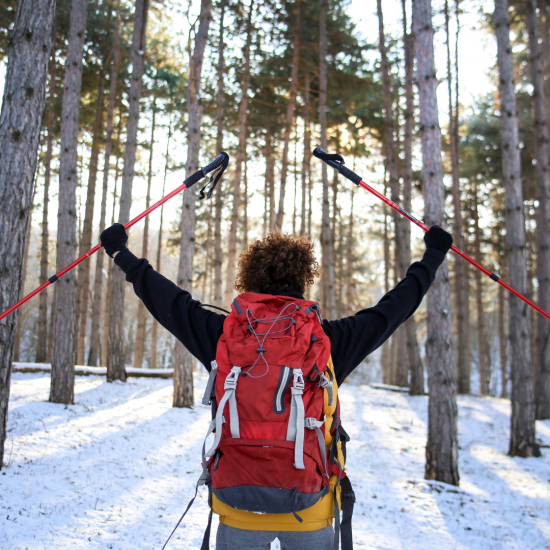Navigating Winter Hiking: Protecting Yourself from Frostbite

As we find ourselves deep into winter, many hiking enthusiasts find ways to enjoy the winter versions of our favorite landscapes. However, the cold weather brings with it a set of challenges that demand extra precautions. Among the risks, frostbite stands out as a serious concern. In this blog post, we'll explore the dangers of frostbite during winter hikes and discuss what you can do to protect yourself from its chilling effects. Among the risks, frostbite stands out as a serious concern. It only needs to be 32ºF (0ºC) for frostbite to set in.
What is Frostbite?
Frostbite arises when skin cells and underlying tissues freeze. The potential aftermath of getting frostbite can vary – from heightened sensitivity to cold conditions and recurring bouts of frostbite, to more severe outcomes, such as permanent tissue loss or, in extreme cases, amputation.
As winter unfolds its icy embrace, it becomes imperative for us to make informed choices. By arming ourselves with knowledge and implementing preventive measures, we can embark on outdoor adventures with confidence without jeopardizing our well-being. It's a call to mindfulness and preparedness, ensuring that the wonders of the winter season are enjoyed responsibly and safely.
Warning Signs of Frostbite
As winter's chill descends upon us, it becomes imperative to be vigilant about the potential dangers that accompany frigid temperatures. Recognizing the warning signs of frostbite is crucial for safeguarding oneself and others from its harmful effects.
Whether navigating snowy landscapes or engaging in outdoor activities, understanding these indicators can be the key to preventing serious cold-related injuries. Below are the several signs of frostbite:
- Frozen skin becomes cold, pale, waxy, numb, and woody from the ice crystals in the tissue and frozen nerves.The longer the freezing lasts, the deeper, more severe, and permanent the frostbite injury can be.
- When frozen tissue rewarms, the injured blood vessels leak fluid. Tiny clots will then form in the smallest blood vessels, causing inflammation and further damage.
- Frostbite that thaws and then refreezes makes the damage worse (like meat taken out of the freezer multiple times).
Three Things to Do to Prevent Frostbite
To prevent frostbite during winter hikes, prioritize three essential measures:
- Wear layers
- Staying warm is paramount and can be achieved through strategic layering – moisture-wicking base layers, insulating middle layers, and a waterproof outer layer. Don’t forget to wear a hat, gloves or mittens, and insulated footwear.
- Protect the skin
- Skin that sticks out farthest from your body is the most vulnerable to frostbite (think: nose, ears, fingers, and toes). Protect these areas from direct exposure to wet, cold, and windy conditions.
- Move to keep warm
- Regular movement helps maintain good blood flow, which helps you maintain overall warmth. It also helps prevent tight clothing from impeding blood circulation.
Dealing with Frostbite
If your skin becomes frostbitten, it’s important to act quickly by following these steps:
- Rapid rewarming*
- The best way to rewarm frostbite is by thawing the skin by immersing it in non-scalding, hot water (around 100°F or 38°C) for 20-30 minutes. This helps restore blood flow and warmth to the frostbitten area.*If you’re in a situation where the skin will potentially get refrozen, it’s best to let the frostbite rewarm on its own. You can cover it with warm clothing, cup the frostbitten area with your hands and breathe onto it, or make direct contact with warm skin.
- Protect the skin
- After rewarming, shield the treated area to prevent additional injury. Use dry, warm clothing or blankets. Avoid tight bandages that could restrict blood flow
- After rewarming, shield the treated area to prevent additional injury. Use dry, warm clothing or blankets. Avoid tight bandages that could restrict blood flow
- Prevent re-freezing
- Keep the affected area away from the cold. Refreezing can exacerbate the damage caused by frostbite. Ensure the skin remains warm and protected.
Rewarming frostbite can be painful as the blood rushes back to the skin and can take up to an hour. Drink plenty of fluids, as staying hydrated helps to increase blood flow to the cold, injured areas.
Amidst the winter wonderland, safety should always be a priority. Download the GOES Health today and enter AHS10OFF for 10% off a premium GOES+ subscription to access valuable information from wilderness medicine experts. Enhance your outdoor experience by staying informed about cold weather risks and learning crucial tips for your well-being. Let's make this winter hiking season a safe and memorable adventure!



